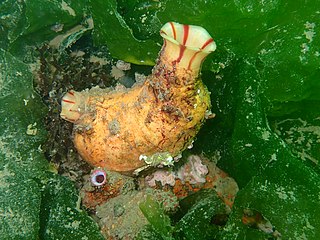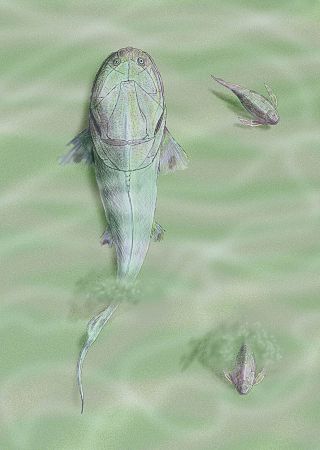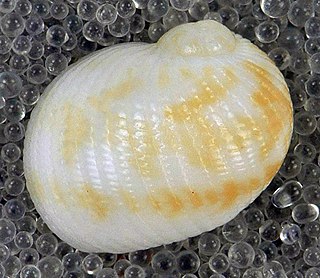
Microcosmus is a genus of tunicates in the family Pyuridae, containing the following species:

Gonidomus is a genus of air-breathing land snails, terrestrial pulmonate gastropod mollusks in the subfamily Orthogibbinae of the family Streptaxidae.

Godfrey of St. Victor was a French monk and theologian, and one of the last major figures of the Victorines. He was a supporter of the study of ancient philosophy and of the Victorine mysticism of Hugh of St. Victor and Richard of St. Victor.

Penion is a genus of large marine snails, commonly known as siphon whelks, classified within the mollusc family Austrosiphonidae.

Microcosmus sabatieri, commonly called the grooved sea squirt, sea fig, or violet, is a species of tunicates. The species has a rocky-shape appearance. It is mainly found in the Mediterranean Sea. It is used as food in parts of Europe.

Pyuridae is a family of tunicates.

Homosteus is a genus of flattened arthrodire placoderm from the Middle Devonian. Fossils are found primarily in Eifelian-epoch aged strata of Europe, Canada, Greenland, and Estonia. All of the species had comparatively large, flattened heads with, as suggested by the upward opening orbits, upward-pointing eyes. These adaptations suggest that the various species were benthic predators. A study on Titanichthys, in contrast, suggests that species of Homosteus may have been filter-feeders instead.

Otiorhynchus is a large genus of weevils in the family Curculionidae. Many species of the genus, particularly the black vine weevil and the strawberry root weevil, are important pests, both as larvae and as adults. Larvae feed on plant roots. Adults are flightless with fused elytra and feed at night on plant foliage. In many species of the genus at least some races are polyploid and parthenogenetic, while the rest of the races and species are diploid and bisexual. Otiorhynchus weevils, particularly O. scaber, have been a popular subject for studies of the evolution of parthenogenesis. The genus is native to the Palearctic region. However, sixteen species were inadvertently introduced to North America and have become widespread there.

Acilius sulcatus is a species of water beetle in the family Dytiscidae. It is fairly large, with color variation shown throughout its range. Typically it is yellow and black.
Ceratomyxa is a genus of myxozoan.

Conus sulcatus, common name the grooved shell, is a species of sea snail, a marine gastropod mollusk in the family Conidae, the cone snails and their allies.

Planaxis is a genus of small sea snails, marine gastropod mollusks in the family Planaxidae.

Stigmaulax is a genus of predatory sea snails, marine gastropod mollusks in the subfamily Naticinae of the family Naticidae, the moon snails.
Legerella is a genus of parasitic alveolates of the phylum Apicomplexa. Species in this genus that usually infect the malpighian tubules of invertebrates.
The Syncystidae are a family of parasitic alveolates in the phylum Apicomplexa. Species in this family infect insects (Aeshnidae).
Syncystis is a genus of parasitic alveolates in the phylum Apicomplexa.
Lipotropha is a genus of parasitic alveolates of the phylum Apicomplexa.

Heterocyathus is a genus of coral of the family Caryophylliidae.
Taphrosphys is an extinct genus of bothremydid pleurodiran turtle that was discovered Angola, Morocco and the United States. The genus consists of type species Platemys sulcatus, T. ippolitoi, T. congolensis, and the dubious T. dares.
Hegetotheriopsis is an extinct genus of hegetotheriid notoungulate. It lived from the Late Oligocene to the Early Miocene, and its fossilized remains are found in Argentina.











